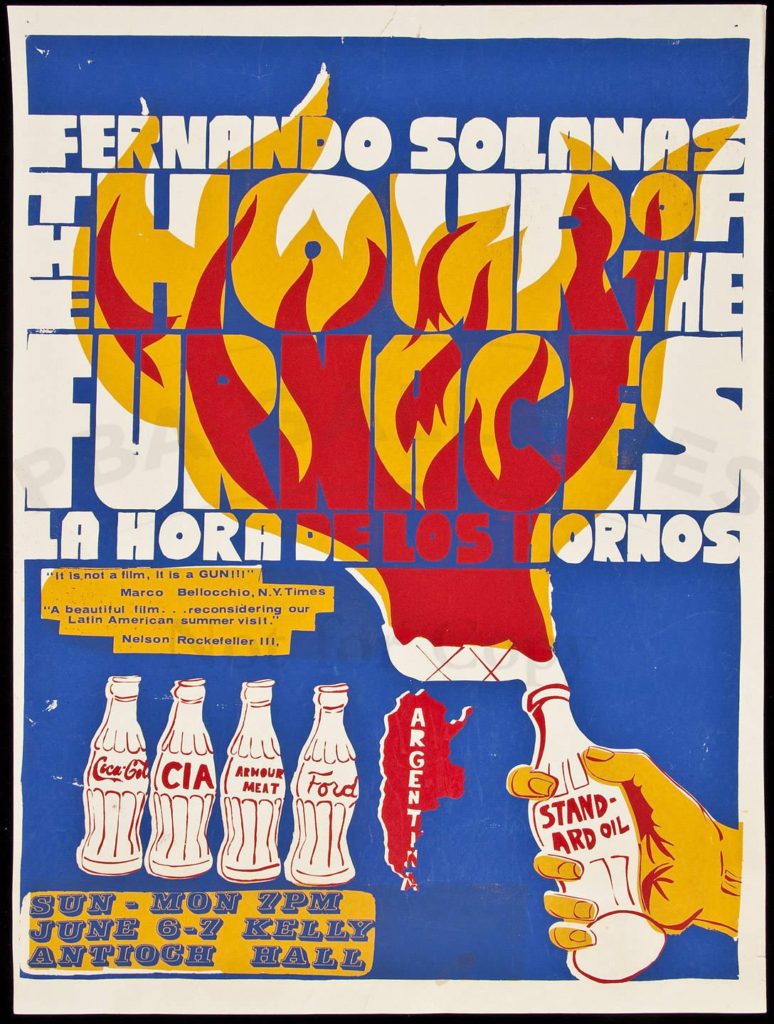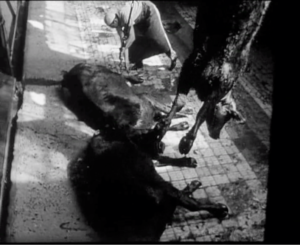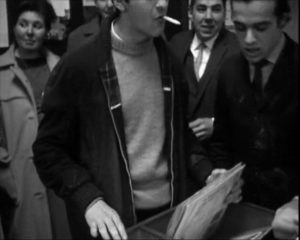
Perhaps one of the most memorable moments from 1960s militant cinema is the slaughterhouse scene in Hora de los hornos (Hour of the Furnaces, Argentina, 1968). 1 Midway through the essay film’s first section, “Neo-colonialism and Violence,” soft female vocals play over an extended montage of sheep and cattle being delivered to a slaughterhouse, hung upside down, their throats slit or the back of their necks pummeled with a sledge hammer, skinned and bled out as their carcasses move along an assembly line. Often discussed as a citation of Sergei Eisenstein’s Strike (USSR, 1925), the footage of industrial agribusiness, one of Argentina’s most lucrative industries, is paired with popular advertisements and intertitles that speak of Argentina’s national debt. An exposition of dependency theory, this section of Hora de los hornos offers a complex critique of the relationship between finance, imperialism, and violence.
Returning to post-war theories of dependency through Hora de los hornos, I contend that critiques of finance leveled by Third Worldist struggles for national liberation in the late 1960s bring us back to crucial questions about the relationship between imperialism and so-called “cultures of finance” that have been too-often neglected in recent years. In particular, the state of bankruptcy under imperial rule interrogated by Hora de los hornos allows us to consider what Randy Martin diagnosed as the “financialization of daily life” together with what the Situationists called the “colonization of everyday life” within capitalism. The perspective of Hora de los hornos, however, is one that surpasses each of these theses by insisting that quotidian violence is inseparable from imperialism as a historical and cultural process.
To understand the critique of finance put forward by Hora de los hornos, we first have to acknowledge that financial systems have their origins in colonial and imperial violence. Take the 1781 Zong slave ship massacre, for example, in which the crew cast 133 captives into the Atlantic, allowing their “owners” in Liverpool to file insurance claims for the drowned “cargo.” For Ian Baucom, this massacre and its aftermath inaugurate what he calls the “speculative discourse” of modernity, connecting the violence of the middle passage to the birth of insurance and other forms of financial speculation. 2 K-Sue Park similarly argues that the practice of foreclosure has its origins in the expropriation of indigenous lands in the early colonial period of North America. 3 Contemporary scholars are not the first to notice that key financial technologies were developed in the course of colonial expropriation during the brutal passage from mercantile to industrial capitalism. In the chapters on primitive accumulation in Capital, volume 1, Marx himself tells the interpenetrating story of the rise of the modern banking system, national debt, and the “idyllic proceedings” of colonial plunder across the globe, concluding that capital comes into the world “dripping from head to toe, from every pore, with blood and dirt.” 4
Picking up this thread, Marxists in the early part of the 20th century developed a critique of finance in order to reckon with imperialism, or the intensification and systemization of practices of capital accumulation on a global scale. Drawing on the work of Austrian economist Rudolf Hilferding, Lenin argued in 1917 that
imperialism, or the domination of finance capital, is that highest stage of capitalism in which this separation [of money capital from productive capital] reaches vast proportions. The supremacy of finance capital over all other forms of capital means the predominance of the rentier and of the financial oligarchy; it means that a small number of financially “powerful” states stand out among all the rest. 5
In Lenin’s assessment, the predominance of finance enabled imperialism’s central features: monopoly capitalism and the growing export of capital from financial centers. With regards to the latter aspect, the export of capital, Lenin was pulling from the work of Rosa Luxemburg who demonstrated several years earlier that capital exports, particularly in the form of international loans, were the foundation of imperialist accumulation. Initiating a permanent cycle of indebtedness in order to realize profits in industrial centers, international loans were responsible for the immiseration of local populations and the continuous outbreak of financial crises across the global south. In her blistering account of imperialism in Egypt, Luxemburg demonstrates how loans initially given to build the Suez Canal and modernize agriculture set into motion a permanent crisis, leading to the proletarianization of the peasant population and eventual foreign occupation: “The case of Egypt, just as that of China, and more recently, Morocco, shows militarism as the executor of the accumulation of capital, lurking behind international loans, railroad building, irrigation systems, and similar works of civilization.” 6 Finance is the lever of what David Harvey calls “accumulation by dispossession,” a means for capital to penetrate its “outside” and to bring evermore territories and people into its fold.
By the post-war era, Marxist critiques of imperialism flourished in the early post-colonial theories of dependency advanced by Latin American structuralists such as Raúl Prebisch and Juan Noyola, later popularized in the world-systems theory of Immanuel Wallerstein. Throughout the 1960s and into the 1970s, dependency theory took hold in Latin America and elsewhere as a rebuttal to the modernization theory of development, which posited successive stages through which nations pass on the path to industrial wealth. Introducing terms that have become indispensable to analyzing global inequality among nation states, dependency theory argued that the wealth of the first world – “core” countries in the global capitalist system – was generated through the systematic underdevelopment of countries on the “periphery” of the global system. Brazilian social scientist Theotonio Dos Santos wrote prolifically on dependency theory while in exile in Chile from 1965–1973 before being exiled again to Mexico after Pinochet’s coup, arguing that the “new dependency” characteristic of global imperialism is predicated on systematic industrial and technical underdevelopment of peripheral countries, primarily through the mechanisms of financial control by way of foreign debts. The model of dependency, a mode of production characterized by the continuous reproduction of “backwardness, misery, and social marginalization” within peripheral countries, perpetuates and expands debt, and is thus “superexploitation.” 7 With close affinity to Lenin and Luxemburg, as well as contemporaneous analyses like Kwame Nkrumah’s theory of “neo-colonialism,” dependency theory foregrounded the asymmetrical power relations in finance that drive the imperialist production of global inequality. It offered a structural analysis of global inequality that bolstered, while also being fed by, the wave of anti-imperialist revolutionary activity sweeping the continent.
The slaughterhouse scene discussed above comes from the chapter of Hora de los hornos entitled “Dependency,” and it is the film’s attempt to render dependency theory’s critique of imperial finance, particularly capital exports and national debt, in cinematic form. However, the film significantly expands earlier critiques of imperial finance by placing them within a broader politics of cultural decolonization. Produced clandestinely under the military dictatorship of Juan Carlos Onganía, installed in 1966 amidst growing student and worker unrest, Hora de los hornos promoted a left-Peronist agenda, although the film’s political project was more expansive than its stated allegiance to the exiled Perón. A year after making Hora de los hornos, Fernando Solanas and Octavio Getino published their landmark essay “Towards a Third Cinema” in Tricontinental, a journal produced by the Organization of Solidarity with the Peoples of Asia, Africa, and Latin America (OSPAAAL). In it, they argue that cinema, one of the most effective means of mass communication, must be seized and employed in the struggle against imperialism as a crucial weapon in the “decolonization of culture.” 8 Beyond the economism of most dependency theorists who saw culture as little more than “perfume,” 9 the practice of Third Cinema reflected in Hora de los hornos (with a significant debt to Frantz Fanon) takes culture to be inextricable from any discussion of dependency: “The culture, including cinema, of a neocolonized country is just the expression of an overall dependence that generates models and values born from the needs of imperialist expansion.” 10 Modeling cinematic production on guerrilla warfare, Solanas, Getino, and the “Cine-Liberación” group to which they belonged sought to use the medium as a means to build national and international solidarities among anti-imperialist movements. They did so by constructing a militant cinematic form and infrastructure to advance collective authorship and production, engaging workers, students, peasants, intellectuals, and revolutionaries as collaborators.
Advancing a pan-Latin-American political project within the context of a Tricontinental perspective, the opening sequence of Hora de los hornos is composed of footage of police brutality and protest, inter-cut with quotations on colonial liberation and violence from Frantz Fanon, Aimé Césaire, Fidel Castro, and others. The film develops its critique of neo-colonialism through an examination of the everyday violence of life in Latin America, layering moving and still images, found footage, text, and sound to imbricate all facets of life into a total system of domination and subjugation. The first section, “Neo-colonialism and Violence,” presents the overarching thesis that “Latin America is a continent at war,” and is composed of twelve chapters with titles such as “History,” “Culture,” “Ideological Warfare,” and “The System.” Each of these chapters addresses a different aspect of the thesis, expanding the definition of war and its frontiers to incorporate the unspoken forms of imperial violence running through collective life and daily experiences. For example, in the section “Daily Violence,” the sound of the siren grows louder and more ominous as the sequence cuts to footage of people running through the city, with what sounds like gunfire enveloping the scene, giving us the impression that we are viewing a war zone. It soon becomes apparent, however, that these shots are of people running through the rain (perhaps on their way to work). At the same time, what sounded like gunfire is revealed in the next sequence to be the sound of workers punching a time clock. Through the juxtaposition of sound and image, this sequence takes quotidian experiences and produces what appears to be a scene of war. Wage-labor is a form of daily violence visited upon the people, and the punctuation of time by work imposes a visceral terror on those who endure it. Throughout Hora de los hornos, the aural environment is a political space, as the sounds of popular music, a plane landing, and the punch of the time clock become emblems of violence and calls to revolutionary action. These calls would have been all the more urgent to viewers seeing the film in covert screenings, at their own risk, in the context of a repressive military regime. In these spaces, Hora de los hornos sought to reshape the concept of cinephilia by inducing, rather than stifling, political participation through spectatorship; the film was intended as provocation to its viewers, who were, in turn, interpellated as participants in its revolutionary project. 11
Hora de los hornos engages in nothing less than a total critique of the bankruptcy of life under the neo-colonial regime, portraying a society whose accumulated debts to imperial powers have outstripped its capacity to function, producing a permanent condition of indebtedness. In the “History” chapter, a voiceover contends that the oligarchies of Argentina were the product of three factors: “English gold, Italian hands, and French books.” This claim is reinforced with footage of the Argentine national railroad, one of the 19th-century infrastructure projects that Luxemburg saw as integral to British imperialist accumulation. The film illustrates how cultural and economic debts are two sides of the same crisis of national identity and attends to the violence of cultural imperialism, arguing, in the vein of the movements for national liberation across the globe, for the development of a national culture in a form and language indigenous to Argentina. While tracing Argentina’s colonial legacy, Hora de los hornos also examines a shift away from this oligarchic system, illustrating that neo-colonial violence now trades in only one currency: “Yankee dollars.” Cultural imperialism and global financial systems had been melded into one and the same substance, a mode of domination and control enveloping every aspect of social, economic, and political life.
Over a panning shot of the harbor of Buenos Aires, the “Dependence” chapter commences with a quotation from 1544 by Sebastián Caboto, an early Italian explorer: “Those who live in rural areas say there are mountains where they mine endless gold.” The camera then slowly pans to reveal the immensity of the city accompanied by a voiceover that delivers a sharp critique of the debt economy imposed on Latin America:
Loans, Investments, have always been a part of the same political subjugation […] So-called imperialist aid is an aid that always cost he who receives it more than he who gives it. For every dollar invested in Latin America, imperialism gets back four.
And so begins the carnage of the slaughterhouse, which is interspersed with advertisements, all displaying smiling, white models extolling the virtues of consumer society. Inserted within this montage are also stark intertitles explaining the basic theses of dependency theory: “everyday we export more and get back less,” “Argentina’s foreign debt is six billion dollars,” and “the foreign monopolies and their local allies control almost all the national economy,” and listing the industries that are under foreign control. Paired with footage from the slaughterhouse, these figures of debt illustrate a body politic that is literally bleeding out its capacities. Juxtaposed with advertisements promising a better life through consumption, these figures indicate that culture, like the national economy, is bankrupt. Hora de los hornos offers a critique of the spectacle and finance capitalism as dual mechanisms mining human (and nonhuman) resources for the promise of infinite riches, the endless gold in the mountains of which Caboto speaks.
Contradicting the linear and teleological temporal framework of modernization theory, Hora de los hornos’s portrayal of dependency testifies to a different kind of temporal experience: that of debt and indebtedness. The mechanisms of social reproduction that constantly reinforce social hierarchies predicated on a system of debt induce the experience of a collapsed futurity, one in which “development” – representing the potential for a different future – is foreclosed. Exploring this temporality, Hora de los hornos expands the theoretical framework of dependency theory to analyze the role of systems of social reproduction – art, language, education, media, folklore, etc. – as sites that propagate and reinforce dependency and underdevelopment. This sequence conveys the affective dimensions of the indebted position, the attachment and striving for a better life figured by the advertisements and experience of being bled dry that accompany such attachments, a kind of “cruel optimism” in the words of Lauren Berlant. 12 Rather than simply translating the concept of dependency into the cinema, Hora de los hornos expands an analysis of the violence of neo-colonialism, impressing upon the viewer complex arguments within an affective register.
Hora de los hornos later reinforces the affective character of this indebted position in the chapter on “Ideological Warfare,” which opens with a mobile shot of a street scene that meanders through crowds as they enter movie theaters and shops. A voiceover contends that, “the war in Latin America is waged principally in the minds of men […] For neo-colonialism, mass communication is more powerful than Napalm.” As a woman stops to watch several television screens in a shop window, the voiceover continues, “ideological frontiers have replaced conventional ones,” with the ideological frontier appearing as an mobile and open boundary. Undiagetically, “I Don’t Need No Doctor” by Ray Charles begins to envelop the scene as the camera wanders into a record shop where young people peruse the records as they tap their fingers and bob their heads. The sequence cuts between different angles of the scene, focusing on one man who is particularly taken with the music, the shot lingering on him as his body convulses as he shops. The non-diegetic music is edited with the footage in a way that does not exactly sync with the man’s gestures, introducing an interstice between image and sound that turns his undulations into an almost repulsive expression of submission. As this sequence reveals, the ideological frontier in imperialism operates on an affective, pre-cognitive level, turning moments of consumption into moments of production – the production of neo-colonial subjectivity.
“Everyday life is a colonized sector.” 13 Guy Debord made this argument in 1961 (drawing on the work of Henri Lefebvre) with reference to the expansion of consumer culture in industrial societies. Amidst the Algerian war for independence, and a few months before the massacre of dozens of Algerians in Paris, Debord casts the struggle over daily life – and the struggle against the spectacle – within terms inspired by anti-colonial movements. Hora de los hornos, however, goes beyond Debord’s analysis. For it, colonization is not a metaphor, but an active and ongoing process of historical domination that penetrates every aspect of life. Rather than representing a new, abstract mode of production that Debord identifies as “the spectacle,” Hora de los hornos understands the colonization of daily life to be the ever-increasing expansion and intensification of imperialism. This daily violence, for Hora de los hornos, is inseparable from imperialist mechanisms of finance that feed the continuous cycle of dispossession and serve as a source of unending crisis. Hora de los hornos is less concerned with the alienation of the commodity that Debord decries than it is with a cultural imperialism that forms subjects through modes of expropriation that are inseparable from the violence of imperial finance.
In its foresight, Hora de los hornos anticipates the massive bleeding out that Argentina - along with a host of other underdeveloped nations - would be subjected to as neoliberal laboratories established during 1970s, leading to decades of foreign debt and structural adjustment culminating in the 2001 financial crisis and default. 14 At the same time, it analyzes the affective, economic, political, and historical dimensions of the experience of indebtedness prior to the apparent rise of forms of neoliberal governance, identifying the salient aspects of debt as a technology of power, the acknowledgement of which has become widespread in the aftermath of the 2008 financial crisis. 15 In doing so, it combines its more robust cinematic theorization of the “colonization of everyday life” by capitalism with an early recognition of what Randy Martin called the “financialization of daily life” in reference to the expansion of consumer credit and the production of financialized subjectivities in the neoliberal era. 16 While conversations around the relationship between imperialism and finance have been ongoing in Latin America, these connections have been largely missing in discussions of “cultures of finance” in the United States since the financial crisis. What would it mean to recenter our critiques of finance and financialization around an anti-imperialist politics? To begin, we might ask if the so-called “financialization of daily life,” beginning in the early-2000s in the United States, is really something new, or whether, as some have suggested, it signals the further extension of imperial finance within centers of capital accumulation. Here, the logic of the “internal colony,” a term utilized by various activists in the 1960s to describe conditions of colonization in centers of capitalist command and which foregrounded alliances with struggles for national liberation abroad, might be useful to understand how victims of the subprime mortgage crisis, student loan crisis, and numerous other schemes of debt and indenture have been subject to something like the colonization of daily life by finance. An optic that privileges Marxist critiques of imperial finance might also help us to better articulate the links between, for example, the bankruptcies in Puerto Rico and Detroit, or the militarization of police violence in Ferguson and the debt peonage imposed on that city’s inhabitants by civic government. 17 Hora de los hornos leaves us with the insight that to begin to approach the question of imperial finance and resistance to it, however, we must constantly foreground culture and the production of subjectivity, attending to the ways each is bound to legacies of colonial and imperial violence.
References
| ↑1 | This piece is taken from my forthcoming book, Enduring Images: Towards a Future History of New Left Cinema (Minneapolis: University of Minnesota Press, 2018). |
|---|---|
| ↑2 | Ian Baucom, Specters of the Atlantic: Finance Capital, Slavery, and the Philosophy of History (Durham: Duke University Press, 2005). |
| ↑3 | K-Sue Park, “Money, Mortgages, and the Conquest of America,” Law & Social Inquiry 41, no. 4 (Fall 2016): 1006–35. |
| ↑4 | Karl Marx, Capital, trans. Ben Fowkes, vol. 1 (New York: Penguin, 1992), 926. |
| ↑5 | V.I. Lenin, Imperialism, The Highest Stage of Capitalism: A Popular Outline, in Lenin: Collected Works, trans. Yuri Sdobnikov, vol. 22 (Moscow: Progress Publishers, 1974), 238–39. |
| ↑6 | Rosa Luxemburg, The Accumulation of Capital, trans. Agnes Schwarzschild (London: Routledge & Kegan Paul, 1951), 439. |
| ↑7 | Theotonio Dos Santos, “The Structure of Dependence,” in Contemporary Latin American Social and Political Thought: An Anthology, ed. Iván Márquez (Lanham, Maryland: Rowman and Littlefield Publishers, 2008), 238. |
| ↑8 | Fernando Solanas and Octavio Getino, “Towards a Third Cinema,” in Film and Theory: An Anthology, eds. Robert Stam and Toby Miller (Malden, Mass.: Blackwell, 2000), 268. |
| ↑9 | As Michael Denning argues, the Latin American dependency theorists consistently overlooked the importance of culture, understanding it to be little more than “perfume.” Michael Denning, Culture in the Age of Three Worlds (London: Verso, 2004), 9. |
| ↑10 | Solanas and Getino, “Towards a Third Cinema,” 268. |
| ↑11 | By troubling the conventions of spectatorship, the film complements simultaneous experiments in art and theater in Argentina, such as the Rosario Group’s Ciclo de Art Experimental (Cycle of Experimental Art, 1968) and Augusto Boal’s influential Theater of the Oppressed, that similarly sought to engage spectators as agents of resistance. |
| ↑12 | Lauren Berlant, Cruel Optimism (Durham: Duke University Press, 2011). |
| ↑13 | Guy Debord, “Perspectives for Conscious Alterations in Everyday Life,” in Situationist International Anthology, ed. and trans. Ken Knabb (Berkeley, CA: Bureau of Public Secrets, 1989), 70. |
| ↑14 | For a full account of the 2001 sovereign debt crisis and the legacy of dependence, see David Rock, “Racking Argentina,” New Left Review II, no. 17 (2002): 55–86. |
| ↑15 | For example, Maurizio Lazzarato identifies debt as a social relation central to the production and reproduction of inequality in neoliberal capitalism. Like most theorists and historians of the topic, he signals the mid-1970s as the onset of the neoliberal era and thus debt’s predominance as a technology of subjugation. Lazzarato describes the rise in consumer debt in the United States and Europe and the rise of neoliberal entrepreneurial subjectivity at the root of the 2008 subprime crisis, along with the sovereign debt crisis in Europe that persists in the present. However, his Eurocentric analysis does not account for the ways that debt was intrinsic to colonial and imperial projects preceding the neoliberal era. See Maurizio Lazzarato, The Making of the Indebted Man: An Essay on the Neoliberal Condition, trans. Joshua David Jordan (Los Angeles: Semiotext(e), 2011). |
| ↑16 | Randy Martin, The Financialization of Daily Life (Philadelphia: Temple University Press, 2002). |
| ↑17 | See Ben Kesling, “Lawsuit Alleges Ferguson, Mo., Legal System Violates Constitutional Protections: Suit Alleges St. Louis Suburbs Jain People Solely for the Inability to Pay Fines, Fees on Minor Offenses,” Wall Street Journal, February 9, 2015. Also Cassie Thornton and Max Haiven have begun the important work of mapping the spaces of debt and resistance in relation to U.S. empire; see Cassie Thornton and Max Haiven, “The Debts of the American Empire - Real and Imagined,” ROAR Magazine 3 (September 2016). |
 Viewpoint Magazine
Viewpoint Magazine



